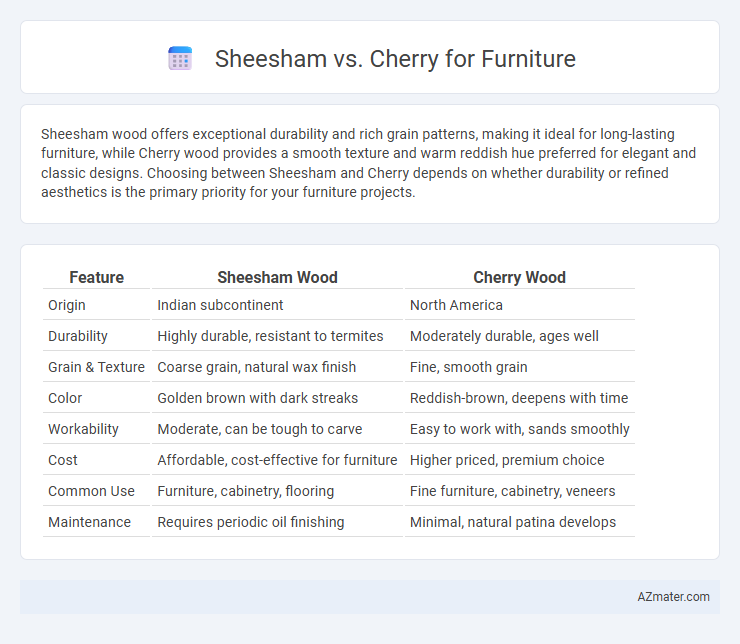Sheesham wood offers exceptional durability and rich grain patterns, making it ideal for long-lasting furniture, while Cherry wood provides a smooth texture and warm reddish hue preferred for elegant and classic designs. Choosing between Sheesham and Cherry depends on whether durability or refined aesthetics is the primary priority for your furniture projects.
Table of Comparison
| Feature | Sheesham Wood | Cherry Wood |
|---|---|---|
| Origin | Indian subcontinent | North America |
| Durability | Highly durable, resistant to termites | Moderately durable, ages well |
| Grain & Texture | Coarse grain, natural wax finish | Fine, smooth grain |
| Color | Golden brown with dark streaks | Reddish-brown, deepens with time |
| Workability | Moderate, can be tough to carve | Easy to work with, sands smoothly |
| Cost | Affordable, cost-effective for furniture | Higher priced, premium choice |
| Common Use | Furniture, cabinetry, flooring | Fine furniture, cabinetry, veneers |
| Maintenance | Requires periodic oil finishing | Minimal, natural patina develops |
Introduction to Sheesham and Cherry Wood
Sheesham wood, also known as Indian rosewood, is prized for its rich, dark grain patterns and high durability, making it a favored choice for premium furniture. Cherry wood, recognized for its smooth texture and warm reddish-brown hue, offers excellent workability and ages beautifully with a natural patina. Both woods provide distinct aesthetic and functional qualities ideal for crafting long-lasting, elegant furniture pieces.
Origin and Availability
Sheesham wood, native to the Indian subcontinent, is widely available in regions like India, Pakistan, and Nepal, prized for its rich grain and durability. Cherry wood, originating from North America and parts of Europe, is valued for its smooth texture and reddish-brown hue, with availability largely concentrated in the United States and Canada. Both woods are sustainably sourced but differ in regional abundance and export markets, influencing furniture production and pricing globally.
Appearance and Color Differences
Sheesham wood features a rich, dark brown hue with natural grain patterns that create a rustic, traditional look ideal for vintage or earthy furniture styles. Cherry wood boasts a warm, reddish-brown color that deepens over time, offering a smooth, elegant finish perfect for classic and contemporary furniture designs. The color stability of Cherry wood surpasses Sheesham, which can exhibit more pronounced grain variation and color inconsistencies due to its natural growth patterns.
Grain Patterns and Texture
Sheesham wood features a rich, bold grain with distinctive dark streaks that create a dramatic and luxurious appearance, making each furniture piece unique. Cherry wood displays a fine, smooth grain with a warm, reddish-brown hue that deepens over time, offering a classic, elegant texture ideal for refined furniture designs. Both woods provide durability, but Sheesham's pronounced grain patterns stand out more prominently, while Cherry's silky texture lends a softer, more uniform finish.
Durability and Hardness Comparison
Sheesham wood, also known as Indian rosewood, offers superior durability with a Janka hardness rating of approximately 2,440 lbf, making it highly resistant to scratches and dents for furniture. Cherry wood, with a Janka hardness around 995 lbf, is softer and more prone to wear over time but develops a rich, deep patina that enhances its aesthetic appeal. For furniture requiring long-term resilience and structural strength, Sheesham is preferred, while Cherry is favored for lighter-use pieces emphasizing beauty and smooth finishes.
Workability and Crafting Suitability
Sheesham wood offers superior workability due to its medium density and fine grain, making it easier to shape and carve intricate designs for furniture. Cherry wood, while slightly harder, provides excellent crafting suitability because of its smooth texture and ability to develop a rich patina over time, enhancing the aesthetic appeal of handcrafted pieces. Both woods are favored by artisans, but Sheesham's natural oils reduce sanding time, whereas Cherry's uniform grain ensures consistent finishes and durability in detailed woodworking.
Maintenance and Longevity
Sheesham wood offers exceptional durability and requires minimal maintenance due to its natural oils that resist moisture and pests, making it ideal for long-lasting furniture. Cherry wood, while also durable, demands more regular care such as polishing to prevent surface scratches and maintain its rich color over time. Both woods provide longevity, but Sheesham's lower upkeep needs make it a preferred choice for furniture that endures years of use with less effort.
Cost and Value for Money
Sheesham wood offers superior durability and rich grain patterns, often commanding a higher price due to its hardness and resistance to termites. Cherry wood is generally more affordable, providing a smooth texture and warm reddish hue that ages beautifully over time, enhancing furniture's aesthetic value. For long-term investment, Sheesham's robustness justifies its cost, while Cherry balances cost and visual appeal, making both excellent value-for-money options depending on preferences and budget.
Environmental Impact and Sustainability
Sheesham wood, sourced from Dalbergia trees, is known for its durability and natural resistance to pests, growing primarily in India and Pakistan where it contributes to sustainable forestry when harvested responsibly. Cherry wood, derived mainly from American cherry trees, offers moderate growth rates and requires managed forestry practices to mitigate deforestation concerns, emphasizing the importance of certified wood sources for environmental sustainability. Both woods provide eco-friendly furniture options when procured through certified sustainable forestry programs, with Sheesham boasting higher carbon sequestration due to its denser wood structure.
Best Applications in Furniture Making
Sheesham wood, known for its durability and rich grain patterns, is ideal for heavy-use furniture like dining tables and cabinets, offering excellent resistance to wear and moisture. Cherry wood provides a smooth texture and warm reddish hue, making it perfect for fine furniture such as dressers, bed frames, and intricate woodwork where aesthetic appeal is paramount. Their contrasting hardness and finishes determine optimal applications: Sheesham suits robust, rustic furniture, while Cherry excels in elegant, polished pieces.

Infographic: Sheesham vs Cherry for Furniture
 azmater.com
azmater.com